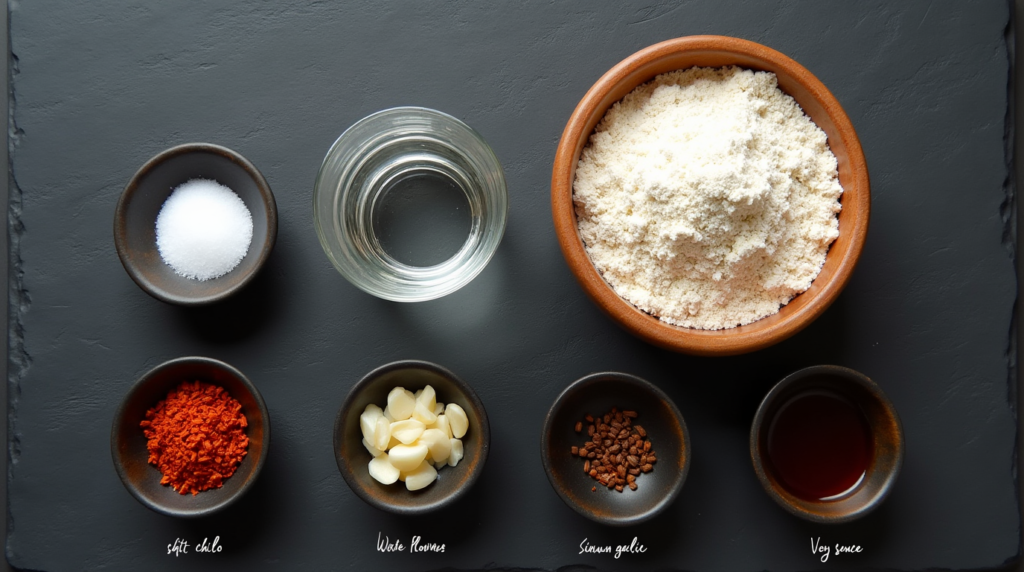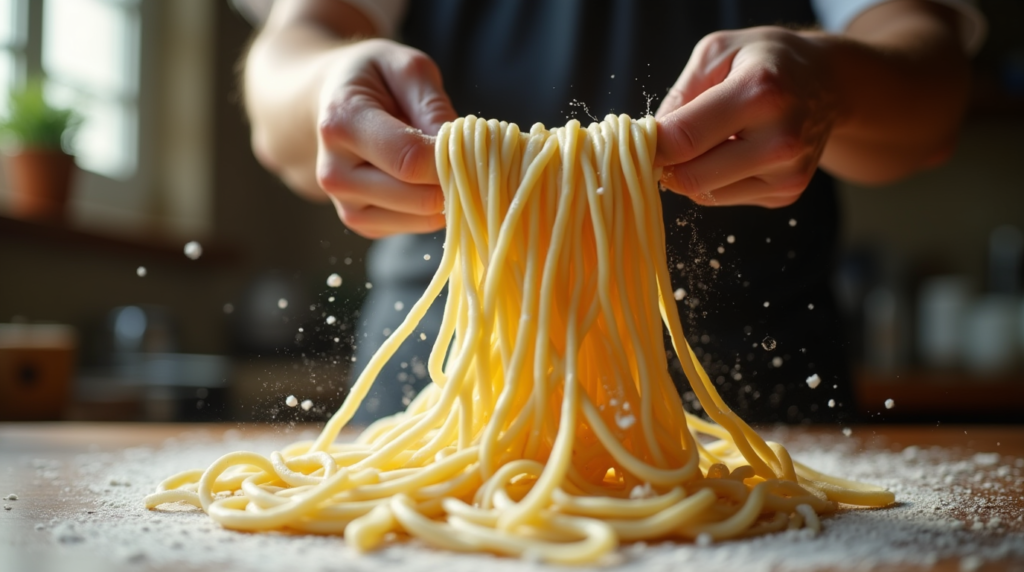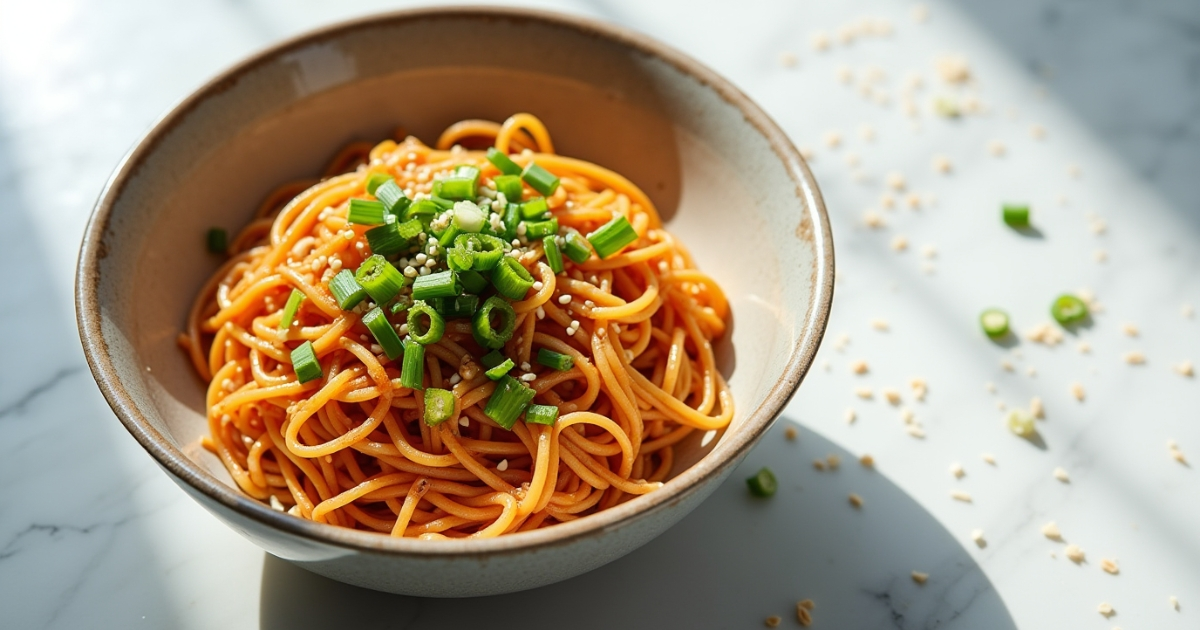Biang Biang Noodles – Authentic Chinese Hand-Pulled Noodles
You are about to embark on a culinary journey to explore the rich flavors and textures of authentic Chinese Biang Biang Noodles. Originating from Shaanxi Province, these hand-pulled noodles have gained worldwide recognition for their unique wide shape and rich flavor profile.
As you delve into the world of Biang Biang Noodles, you will discover the traditional methods behind their preparation and the cultural significance they hold in Chinese cuisine. With their distinctive texture and taste, it’s no wonder why these noodles have become a staple in many Chinese restaurants around the globe.
Key Takeaways
- Biang Biang Noodles are a type of traditional Chinese hand-pulled noodles.
- They originate from Shaanxi Province and are known for their wide shape.
- The noodles have a rich flavor profile and unique texture.
- Biang Biang Noodles have gained popularity worldwide for their authenticity.
- The traditional preparation methods are still used today.
- The cultural significance of Biang Biang Noodles in Chinese cuisine is substantial.
The Rich History of Biang Biang Noodles
Biang Biang noodles have a storied past that weaves together the cultural fabric of Shaanxi Province. As you delve into their history, you’ll uncover the significance of these noodles in the region’s culinary traditions.
Origins in Shaanxi Province
Biang Biang noodles originated in Shaanxi Province, specifically in the city of Xi’an, which is renowned for its rich culinary history. The noodles are a staple in local cuisine, reflecting the region’s agricultural practices and cultural influences.
The Mysterious Character and Name
The name “Biang Biang” is derived from the sound associated with the preparation of these noodles. The character for “Biang” is complex and unique, symbolizing the dish’s importance in local folklore.
| Component | Significance |
|---|---|
| Flour | Primary ingredient, symbolizing simplicity and resourcefulness |
| Water | Essential for dough formation, representing adaptability |
| Salt | Adds flavor, signifying the balance of tastes |
Understanding the etymology of “Biang Biang” provides insight into the cultural significance and the reverence with which these noodles are regarded. The history of Biang Biang noodles is a testament to the rich culinary heritage of Xi’an and Shaanxi Province.
What Makes Biang Biang Noodles Unique
You might be wondering what makes Biang biang noodles so special – it’s their wide, hand-pulled texture. These handmade Biang Biang noodles are distinct due to their broad shape and the craftsmanship involved in their creation.
Defining Characteristics of These Wide Noodles
The wide Biang Biang noodles are characterized by their broad, flat shape, which is achieved through a labor-intensive hand-pulling and slapping process. This technique not only gives the noodles their unique texture but also their thickness and chewiness. The width of the noodles can vary, but they are generally much broader than other types of noodles, making them a standout in Chinese cuisine.
- The width of Biang Biang noodles can range from 1 to 3 inches.
- The hand-pulled texture contributes to their chewy consistency.
- The thickness is achieved through a specific dough preparation and resting process.
Why They’re Called “Belt Noodles”
The nickname “Belt Noodles” is derived from the noodles’ broad, belt-like shape. The term “Biang Biang” itself is onomatopoeic, imitating the slapping sound made during the noodle-making process. The combination of their wide shape and the unique sound associated with their preparation has made handmade Biang Biang noodles a beloved and recognizable dish.
The process of making these noodles involves:
- Preparing the dough with precise ingredient ratios.
- Resting the dough to achieve the right elasticity.
- Pulling and slapping the dough to create the signature wide noodles.
The Cultural Significance in Xi’an Cuisine
Biang Biang Noodles hold a special place in Xi’an cuisine, reflecting the city’s rich culinary heritage. As you explore the cultural significance of this dish, you’ll discover its importance in both everyday life and special occasions.
Street Food Heritage
Biang Biang Noodles are a staple street food in Xi’an, with vendors serving them hot and fresh to locals and tourists alike. The dish is deeply rooted in the city’s street food culture, offering a flavorful and satisfying experience. You can find Biang Biang Noodles at street stalls and markets throughout Xi’an, each serving their own version of this traditional dish.
| Aspect | Description |
|---|---|
| Popularity | Biang Biang Noodles are a favorite among locals and tourists, drawing large crowds to street food stalls. |
| Cultural Significance | The dish represents Xi’an’s culinary identity and is often associated with the city’s rich history. |
| Variations | While traditional Biang Biang Noodles remain popular, modern variations are emerging, incorporating different ingredients and flavors. |
Role in Family Gatherings and Celebrations
Beyond its presence in street food culture, Biang Biang Noodles play a significant role in family gatherings and celebrations. The dish is often served during special occasions, symbolizing good fortune and togetherness. In Xi’an, families come together to share Biang Biang Noodles, strengthening bonds and creating lasting memories.
As you experience Biang Biang Noodles in Xi’an, you’ll appreciate the cultural context in which they’re enjoyed. Whether served at a street stall or during a family celebration, this dish embodies the warmth and hospitality of Xi’an’s culinary traditions.
Essential Ingredients for Authentic Biang Biang Noodles
Authentic Biang Biang Noodles require specific ingredients that contribute to their distinctive flavor and texture. The preparation of these noodles involves two main components: the dough and the sauce.

The Perfect Dough Components
The dough for Biang Biang Noodles is made from high-quality flour, salt, and water. The ratio of these ingredients is crucial for achieving the right texture.
Flour Selection and Quality
The type of flour used is high-protein wheat flour, which provides the necessary elasticity and chewiness to the noodles. “The quality of flour directly impacts the texture of the noodles,” as noted by chefs specializing in traditional Chinese cuisine.
Salt and Water Ratio
The ratio of salt and water to flour is critical. Typically, a small amount of salt is added to enhance flavor, while the water ratio is adjusted to achieve the perfect dough consistency.
Traditional Sauce Ingredients
The sauce is what gives Biang Biang Noodles their characteristic flavor. It includes chili oil, aromatics, and various seasonings.
Chili Oil Preparation
Chili oil is a key component, made by infusing hot chili peppers in oil. This process creates a spicy and aromatic flavor profile.
Aromatics and Seasonings
Aromatics such as garlic and ginger, along with seasonings like soy sauce and vinegar, are added to create a balanced flavor. As one chef puts it, “The harmony of these ingredients is what makes Biang Biang Noodles truly authentic.”
Step-by-Step Guide to Making Handmade Biang Biang Noodles
For those eager to try their hand at making Biang Biang noodles, the journey begins with understanding the basics of the dough and the pulling technique. Making Biang Biang noodles from scratch is a multi-step process that requires patience, practice, and attention to detail.
Preparing and Resting the Dough
The first step in making Biang Biang noodles is preparing the dough. The dough is typically made from a mixture of flour, water, and salt. The proportions of these ingredients can vary, but a common starting point is using 2 cups of flour, 1/2 cup of water, and a pinch of salt. The ingredients are mixed together until they form a cohesive dough, which is then kneaded for about 10 minutes until it becomes smooth and elastic. The dough is then rested for at least 30 minutes to allow the gluten to relax, making it easier to work with later.
As noted by a renowned chef, “The resting period is crucial as it allows the gluten to relax, which is essential for achieving the right texture in Biang Biang noodles.”
“The quality of the dough directly impacts the final product, so it’s worth taking the time to get it right.”
Dividing and Shaping
After the dough has rested, it’s divided into smaller portions. Each portion is then rolled out into long, thin strips. The width of these strips can vary depending on personal preference, but traditionally, Biang Biang noodles are quite wide, hence their nickname “belt noodles.” The strips are then cut to the desired length.
| Step | Description | Time |
|---|---|---|
| 1 | Preparing the dough | 10 minutes |
| 2 | Resting the dough | 30 minutes |
| 3 | Dividing and shaping | 15 minutes |
The Art of Hand-Pulling and Slapping
The final step involves hand-pulling and slapping the noodles to achieve their characteristic texture. This process requires some practice to get right, as it involves stretching and slapping the dough against a surface to create the wide, flat noodles. The technique not only gives Biang Biang noodles their unique texture but also contributes to their rustic, handmade appearance.

To master the hand-pulling technique, it’s essential to be patient and persistent. With practice, you’ll be able to create handmade Biang Biang noodles that are not only delicious but also visually appealing.
Mastering Traditional Biang Biang Noodles Techniques
To truly master Biang Biang Noodles, you need to understand the traditional techniques behind their creation. The process involves a combination of skill, patience, and practice. As you embark on this culinary journey, you’ll discover that the art of making Biang Biang Noodles is as much about the technique as it is about the ingredients.
The Signature “Biang Biang” Slapping Sound
The distinctive slapping sound associated with Biang Biang Noodles is a hallmark of their preparation. This sound is produced when the noodle dough is slapped against the counter, a technique that not only shapes the noodles but also contributes to their characteristic texture. The slapping action helps to develop the gluten in the dough, giving Biang Biang Noodles their signature chewiness.
Common Mistakes to Avoid
When making Biang Biang Noodles, there are several common pitfalls to watch out for. Overworking the dough is a frequent mistake that can lead to tough, rather than tender, noodles. Another error is not allowing the dough to rest adequately, which can result in a less pliable dough that’s harder to shape. Ensuring the right balance of ingredients and not rushing the preparation process are key to avoiding these mistakes.
| Common Mistake | Consequence | Prevention |
|---|---|---|
| Overworking the dough | Tough noodles | Rest the dough adequately |
| Insufficient resting time | Less pliable dough | Allow sufficient resting time |
| Incorrect ingredient balance | Poor texture and flavor | Follow traditional ingredient ratios |
Practice Tips for Beginners
For those new to making Biang Biang Noodles, practice is essential. Start by mastering the dough preparation, ensuring it’s neither too dry nor too wet. Regular practice will help you develop the necessary skills to achieve the perfect slap and texture. It’s also beneficial to watch experienced cooks and take note of their techniques.
By understanding and practicing these traditional Biang Biang Noodles techniques, you’ll be well on your way to creating authentic Biang Biang Noodles that capture the essence of this beloved Chinese dish.
Regional Variations of Xi’an Biang Biang Noodles
As you explore the world of Biang Biang Noodles, you’ll discover that regional differences play a significant role in shaping this traditional dish. The variations within Xi’an, the birthplace of Biang Biang Noodles, are particularly noteworthy.
Northern vs. Southern Xi’an Styles
In Xi’an, the northern regions tend to prefer their Biang Biang Noodles with a heartier, more robust flavor profile, often incorporating stronger seasonings and more pronounced chili oil flavors. In contrast, the southern parts of Xi’an favor a slightly different approach, with a focus on freshness and the use of lighter, more delicate seasonings. This dichotomy is reflected in the diverse preparation methods and ingredient choices.
| Region | Flavor Profile | Notable Ingredients |
|---|---|---|
| Northern Xi’an | Robust, Hearty | Stronger seasonings, Chili oil |
| Southern Xi’an | Delicate, Fresh | Lighter seasonings, Fresh vegetables |
Modern Adaptations Outside China
Beyond Xi’an and China, Biang Biang Noodles have been adapted in various innovative ways, incorporating local flavors and ingredients. For instance, some restaurants in the United States have introduced fusion versions, combining traditional Biang Biang Noodles with elements like Korean chili flakes or Italian herbs. These modern adaptations not only cater to local tastes but also contribute to the global diversity of this traditional Chinese dish.
Traditional Toppings and Accompaniments
When enjoying Biang Biang Noodles, you can customize your dish with an array of toppings and accompaniments. The versatility of Biang Biang Noodles allows you to create a meal that suits your taste preferences. Traditional pairings not only enhance the flavor but also add nutritional value to the dish.
Classic Vegetable Pairings
Biang Biang Noodles are often paired with vegetables that complement their rich flavor. Common vegetable toppings include:
- Julienne carrots for a crunchy texture
- Boiled or sautéed spinach for added nutrition
- Shredded cucumber for a refreshing contrast
- Pickled mustard greens for a tangy flavor
A popular combination is pairing Biang Biang Noodles with hand-pulled bean sprouts and cucumber strips, creating a harmonious balance of textures and flavors.
| Vegetable | Preparation Method | Flavor Profile |
|---|---|---|
| Carrots | Julienne | Crunchy, slightly sweet |
| Spinach | Boiled or sautéed | Nutritious, mildly earthy |
| Cucumber | Shredded | Refreshing, light |
| Mustard Greens | Pickled | Tangy, slightly bitter |
Protein Options for Your Noodles
To add protein to your Biang Biang Noodles, you can choose from various traditional options:
- Braised pork belly for a rich, savory flavor
- Boiled or poached chicken for lean protein
- Stir-fried tofu for a vegetarian option
- Spicy lamb for a bold, spicy flavor
These protein options can be combined with the vegetable pairings to create a well-rounded and satisfying meal.
Spicy Biang Biang Noodles: The Authentic Flavor Profile
For those who crave an authentic Biang Biang Noodles experience, the spicy version is a must-try. The authentic flavor profile of Biang Biang Noodles isn’t just about the texture or the ingredients; it’s also about the bold flavors that come with it, particularly the spicy kick from chili oil.
The use of chili oil in Biang Biang Noodles is a tradition that adds depth and heat to the dish. It’s what makes spicy Biang Biang noodles stand out from other variations. The key to making great chili oil lies in the quality of the ingredients and the preparation method.
The Essential Chili Oil Recipe
Making chili oil from scratch involves a few simple ingredients: chili flakes, oil, garlic, and sometimes Sichuan peppercorns for added depth. To make it, heat oil in a pan and then pour it over chili flakes and other spices. Let it sit for a few minutes to allow the flavors to meld together.
A basic recipe includes:
- 1 cup chili flakes
- 2 cups vegetable oil
- 3 cloves garlic, minced
- 1 tablespoon Sichuan peppercorns, toasted and ground
Combine these ingredients and let them steep for at least 30 minutes. The result is a fragrant and spicy chili oil that’s perfect for authentic Biang Biang noodles.
Balancing Heat with Other Flavors
While the chili oil adds a significant amount of heat, it’s essential to balance this with other flavors to create a harmonious taste experience. This can be achieved by adding ingredients like soy sauce, vinegar, and fresh vegetables.
| Flavor Component | Role in Balancing Heat |
|---|---|
| Soy Sauce | Adds umami and saltiness to balance the spiciness |
| Vinegar | Provides a tangy contrast to the richness of the chili oil |
| Fresh Vegetables | Adds freshness and texture, cooling down the palate |
By balancing these flavors, you can enjoy spicy Biang Biang noodles that are both authentic and delicious.
How to Serve and Eat Wide Biang Biang Noodles
The way you enjoy Biang Biang noodles is just as important as the noodles themselves. The experience of eating these wide, hand-pulled noodles is deeply rooted in tradition, from the vessels used to serve them to the etiquette of consumption.
Traditional Serving Vessels
In traditional settings, Biang Biang noodles are often served in simple, rustic bowls that add to the authenticity of the dining experience. These bowls are typically made of ceramic or clay, materials that help retain the heat of the noodles. The choice of vessel is not just about functionality; it’s also about preserving the cultural heritage associated with this dish.
| Material | Characteristics | Cultural Significance |
|---|---|---|
| Ceramic | Heat retention, durability | Traditional craftsmanship |
| Clay | Natural, earthy flavor | Authenticity, cultural heritage |
Eating Etiquette and Techniques
When eating Biang Biang noodles, it’s customary to use chopsticks. The technique involves slurping the noodles, which is not only acceptable but encouraged as it enhances the flavor and texture experience. You should also appreciate the balance of flavors in the dish, from the savory sauce to the slight chewiness of the noodles.
To fully enjoy your wide Biang Biang noodles, remember to savor the experience. The combination of the noodles, sauce, and your eating technique all contribute to the authenticity of enjoying traditional Biang Biang noodles.
Where to Find the Best Biang Biang Noodles in America
The quest for the best Biang Biang Noodles in America leads to a mix of traditional eateries and modern restaurants. As the popularity of these hand-pulled noodles grows, so does the number of restaurants serving them. You can now find Biang Biang Noodles in various American cities, each offering a unique take on this traditional Chinese dish.
Top Restaurants Serving Authentic Versions
Several restaurants across the US have gained recognition for serving authentic Biang Biang noodles. Notable mentions include Xi’an Famous Foods, a chain with multiple locations, known for its commitment to traditional flavors. Another is Din Tai Fung, a Taiwanese restaurant with a global presence, which occasionally features Biang Biang Noodles on its menu. When searching for Biang Biang Noodles, look for restaurants that emphasize the use of hand-pulled techniques and traditional ingredients.
What to Look for in Quality Hand-Pulled Noodles
To ensure you’re getting high-quality Biang Biang noodles, consider a few key factors. First, the noodles should be made fresh in-house, with a texture that is both chewy and springy. The sauce should complement the noodles without overpowering them, often featuring a balance of chili oil, vinegar, and soy sauce. Additionally, the portion should be generous, as Biang Biang Noodles are meant to be a filling meal. By choosing restaurants that prioritize these elements, you can enjoy an authentic Biang Biang noodles experience.
Conclusion: Embracing the Tradition of These Extraordinary Chinese Noodles
Biang Biang Noodles represent a rich culinary tradition that spans centuries, embodying the essence of Chinese cuisine. As you’ve explored the history, preparation methods, and cultural significance of these extraordinary noodles, it’s clear that they hold a special place in the hearts of many. By understanding the story behind traditional Biang Biang Noodles, you can appreciate the depth and complexity of this beloved dish.
Whether you’re inspired to try making Chinese Biang Biang Noodles at home or seeking out authentic versions in restaurants, the experience is sure to be rewarding. As you explore the world of Biang Biang Noodles, you’ll discover the unique flavors and textures that have made them a staple in Xi’an cuisine. With their wide, hand-pulled strands and savory sauces, Biang Biang Noodles are sure to delight your senses and leave you wanting more.
As you continue to explore the rich culinary heritage of Biang Biang Noodles, consider the cultural significance and tradition that they represent. By embracing this extraordinary Chinese noodle dish, you’ll not only be enjoying a delicious meal but also connecting with a centuries-old tradition that continues to captivate people around the world.
FAQ
What are Biang Biang Noodles?
Biang Biang Noodles are a type of traditional Chinese noodle known for their wide, hand-pulled shape and rich flavor profile, originating from Shaanxi Province.
How are Biang Biang Noodles made?
Biang Biang Noodles are made by hand-pulling and slapping dough into wide, flat noodles, requiring a specific technique and ingredient ratio.
What makes Biang Biang Noodles unique?
Biang Biang Noodles are distinct due to their wide shape, handcrafted nature, and the signature “biang biang” slapping sound during preparation.
Can I make Biang Biang Noodles at home?
Yes, you can make Biang Biang Noodles at home by following a step-by-step guide on preparing and resting the dough, dividing and shaping, and mastering the hand-pulling technique.
What are the essential ingredients for authentic Biang Biang Noodles?
The essential ingredients include high-quality flour, salt, water, chili oil, aromatics, and various seasonings, which together create the distinctive flavor profile.
Are Biang Biang Noodles spicy?
Biang Biang Noodles can be spicy, depending on the amount of chili oil used, which is a key component of the traditional sauce.
Where can I find authentic Biang Biang Noodles in America?
You can find authentic Biang Biang Noodles in top restaurants that serve traditional Chinese cuisine, by looking for quality hand-pulled noodles and traditional preparation methods.
What are some common mistakes to avoid when making Biang Biang Noodles?
Common mistakes include overworking the dough, not achieving the right texture, and failing to master the hand-pulling technique.
Can Biang Biang Noodles be adapted to different tastes?
Yes, Biang Biang Noodles can be adapted with various toppings and accompaniments, such as vegetables and proteins, to suit different tastes.
What is the cultural significance of Biang Biang Noodles?
Biang Biang Noodles play a significant role in Xi’an cuisine and Chinese culinary traditions, symbolizing good fortune and togetherness during family gatherings and celebrations.
Leave a Review & Rate This Recipe!
There are no reviews yet. Be the first one to write one.

